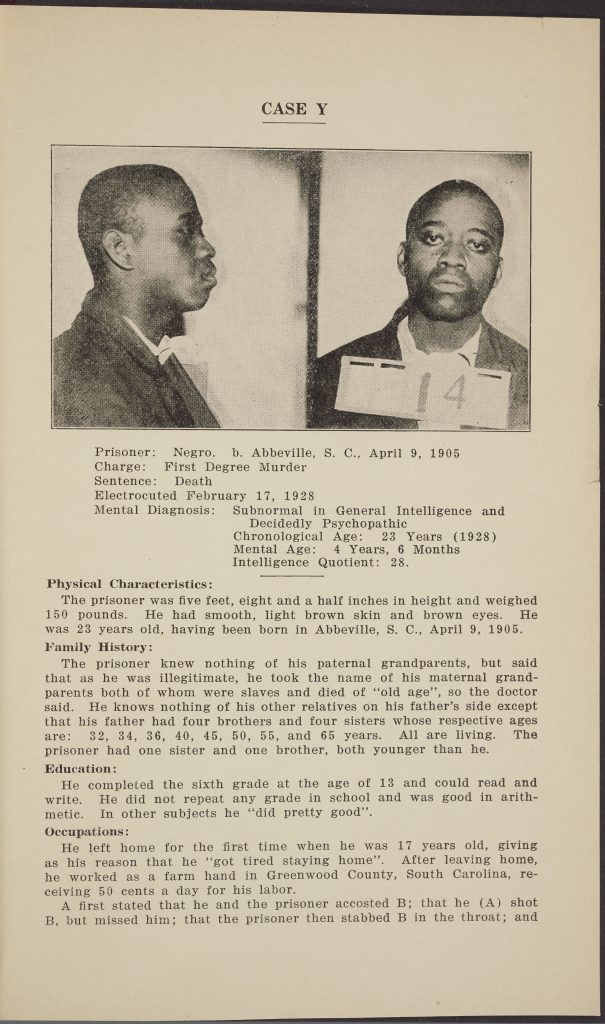Introduction
Andrew Ramseur was a young Black man accused of killing two white people, and the white citizens of Iredell County were clamoring for a lynching. In public forums, they spewed racist epithets and called Andrew a “beast” and a “monkey.” They barraged newspapers with comments like, “He should be hanging from the nearest traffic light as a warning to the rest.” Instead of condemning the racist furor, the district attorney quickly promised the death penalty.
A few months later, Andrew’s family arrived at the courthouse for his trial. Outside, a crowd of angry white people massed in the shadow of a Confederate monument. Inside, crime scene tape inexplicably blocked the rows of seats behind Andrew, forcing his family to sit in the back. In a courtroom where every lawyer, judge and juror was white, they watched a jury sentence Andrew to death.
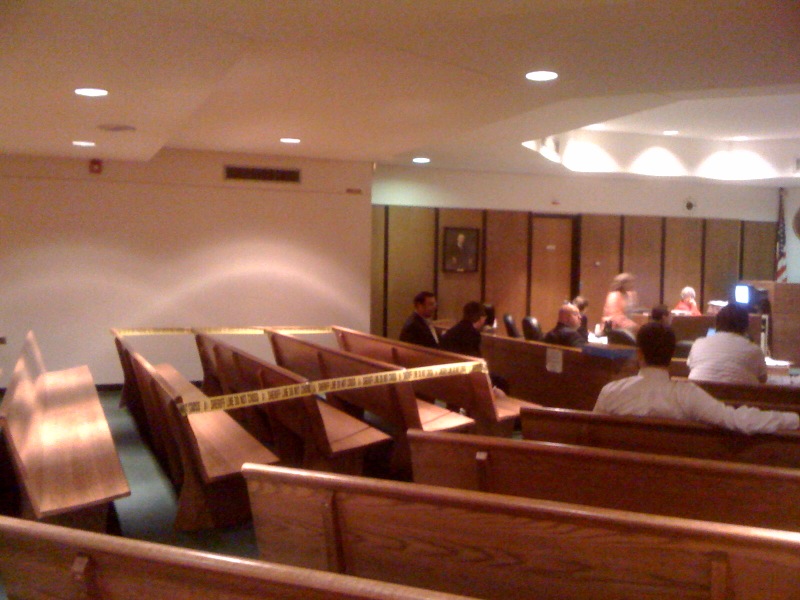
Andrew Ramseur’s trial might sound like something out of the distant past, but it happened in 2010. He is among the newer residents of North Carolina’s death row, which houses about 140 people sentenced to execution since 1985.

The lawmakers, prosecutors, and judges who run the bureaucracy of death in North Carolina may imagine that today’s death penalty has no relation to the state’s brutal history of racial terror and legalized oppression. But the truth is, despite decades of efforts to reform the death penalty, the past is written all over the present.
Imagine North Carolina’s death penalty as a sturdy tree. It grew from a seed planted in the soil of slavery. In the beginning, it was used to ruthlessly enforce the dominance of enslavers. It matured in the years of Jim Crow, when Black people, including children, were frequently sentenced to death under the watchful eyes of lynch mobs, who were ready to do the job themselves if the all-white jury didn’t do it for them.
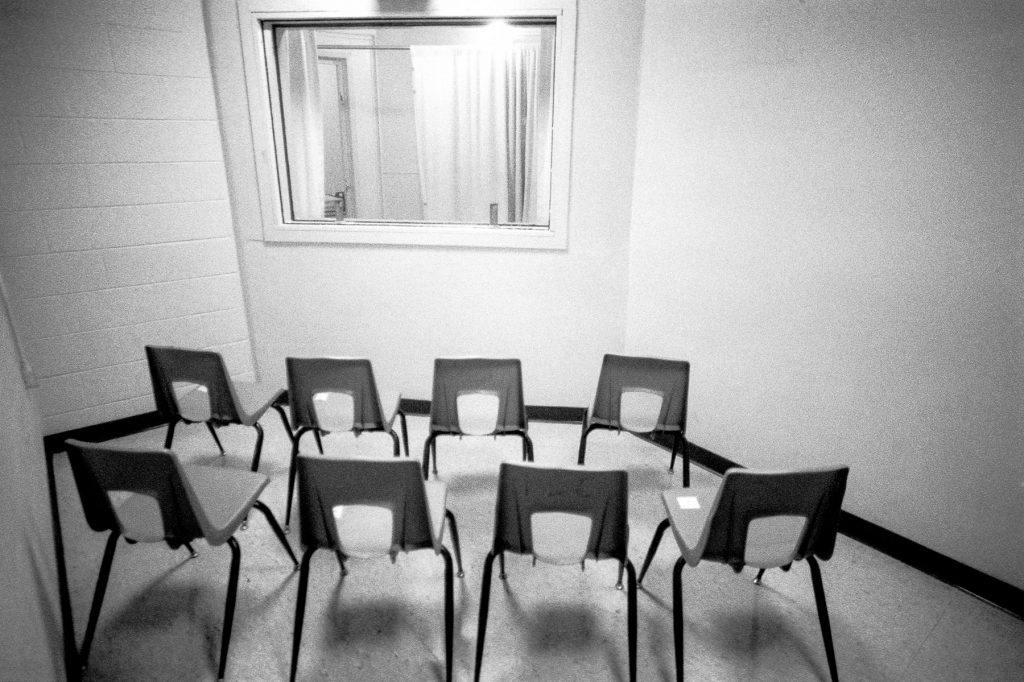
In the early 1970s, the death penalty was struck down by the U.S. Supreme Court, but don’t mistake this period for an uprooting; it was merely a pruning of the death penalty’s most glaring excesses. In 1976, North Carolina revived the death penalty under new laws. It surged with new growth, delivering a fresh bounty of death sentences handed down by overwhelmingly white juries to impoverished defendants, the majority of whom were people of color.
The lawmakers, prosecutors, and judges who run the bureaucracy of death in North Carolina may imagine that today’s death penalty has no relation to the state’s brutal history of racial terror and legalized oppression. But the truth is, despite decades of efforts to reform the death penalty, the past is written all over the present.
Today, people of color make up less than thirty percent of North Carolina’s population but sixty percent of its death row. Black defendants are far more likely to be wrongly convicted. Of the ten death-sentenced people who’ve been exonerated and released in North Carolina, only one was white. The rest were Black or Latino men.
Yet, the targeting of Black defendants is far from the only way that racism permeates the North Carolina death penalty. Nearly half the people on death row had an all-white jury or a jury with only a single person of color. Rigorous statewide studies show that prosecutors strike Black jurors from capital juries at two and a half times the rate of white jurors.
When it comes to the death penalty, white lives matter. Defendants are twice as likely to be sentenced to death if they’re accused of killing a white person. More than three quarters of people executed under current North Carolina laws were executed for killing a white person.
Certainly, the death penalty looks different today than it did in the past. In the nineteenth century, executions were carried out by county sheriffs on public hanging grounds. Thousands of white spectators traveled to picnic, drink, and cheer the death of a Black man at the end of a noose.

In the early twentieth century, as North Carolina sought to burnish its reputation in a modernizing world, the death penalty became more controlled and sanitized. The state took over executions and hid them behind the walls of Raleigh’s Central Prison. It worked to find new methods of killing that were less gruesome for spectators. It built an electric chair, then a gas chamber, and then moved to the sterile and medicalized injection of poison into the veins of a prisoner strapped to a gurney and draped with a clean, white sheet.
But the goal was always to preserve the death penalty, to disguise its true motives and its brutality. The goal was never to root out and destroy the racism on which it feeds.
In what we call the “modern” era, the death penalty continues to achieve exactly what it was intended to do when it began: Punish the powerless and cement the supremacy of the powerful. It remains the ultimate symbol of state control.
It makes Black men the face of violence, while obscuring the fact that throughout American history, white people carried out a sustained campaign of racial terror. It allows society to see an impoverished defendant accused of a single crime as a monster, even as that society fails to hold wealthy people accountable for crimes that cost lives on a much larger scale — corporate fraud and greed, financial scams, environmental degradation, even torture.
The death penalty today is the apex of a criminal punishment system that cages nearly 70,000 people in North Carolina, including children as young as 11 years old. A system that separates families, blights communities of color, and consumes unfathomable quantities of public resources. A system that has turned a blind eye to police brutality and normalized the killings of Black people.
In the past decade, the number of new death sentences has declined, but the death penalty remains a potent force skewing the system toward extreme punishments. Police and prosecutors still routinely use the threat of execution to pressure people accused of crimes into accepting plea bargains. Many defendants give up their constitutional right to a trial and accept death by incarceration, otherwise known as a sentence of life with no possibility of parole, all because the state threatened to seek the death penalty if the case went to trial.
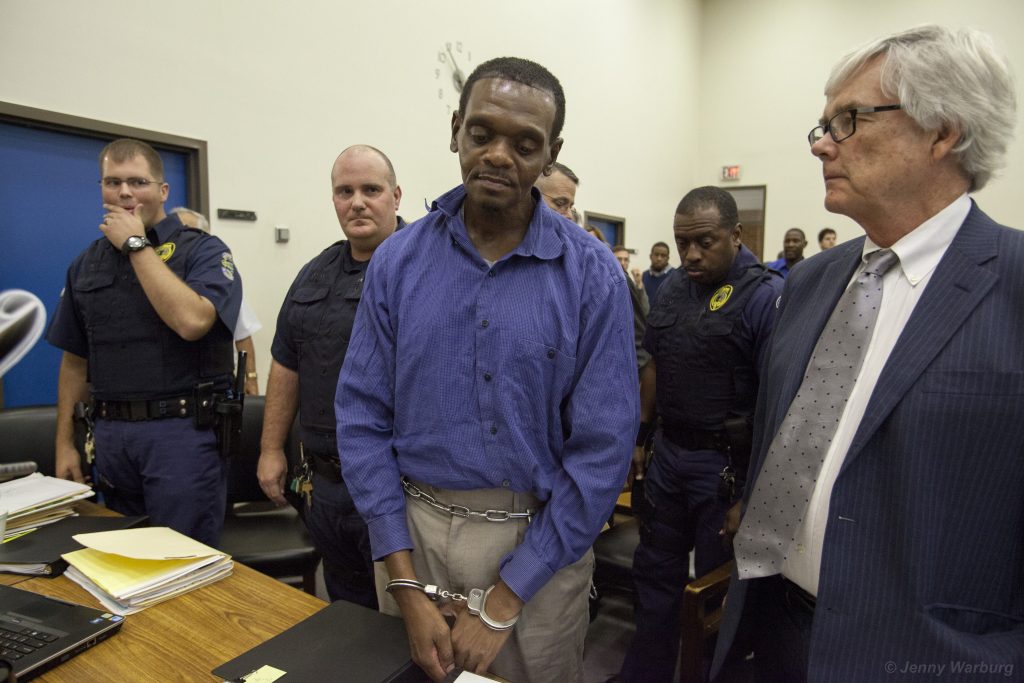
©jenny Warburg
Even as protests rage over the excesses of the criminal punishment system, North Carolina still spends millions each year trying to execute people, and statewide politicians of both parties still proclaim their support for capital punishment. In all these years of state-sponsored killing, North Carolina’s leaders have rarely paused to consider whether a state that enslaved human beings, lynched people, let the Ku Klux Klan run rampant, and sent children to the execution chamber ought to have a death penalty at all.
And not just a death penalty, but one that continues to target Black and brown people at disproportionate rates. One that continues to favor white jurors and value white victims. One that continues to be run almost entirely by white judges, lawyers, administrators, and law enforcement officers. In most courtrooms today, lawyers and judges engage in the fiction that the system is color-blind as they blithely send another poor Black man to prison.
However, Andrew Ramseur’s case is one of many in which the death penalty’s race-neutral facade cracks open and reveals its true nature.
As cries for racial justice sound in the streets, North Carolina’s leaders say they will examine the impact of racism on criminal justice. Governor Roy Cooper formed the North Carolina Task Force for Racial Equity in Criminal Justice, chaired by the state attorney general and a state Supreme Court justice. If the task force is serious about its work, it must reckon with the death penalty, a remnant of slavery that perpetuates its legacy of terror.
Just like a Confederate monument, the death penalty has always been a symbol of white supremacy. Now, there is only one thing left to do with this poisoned tree. Dig it up and salt the earth. Never again assert the state’s power to kill any human being.


Chapter 1: Slavery, Lynching, and the Era of Public Hangings (1619-1910)
Capital punishment arrived in the colony of North Carolina as part of English common law. Even misdemeanors warranted harsh corporal punishment and a long list of felonies qualified for the death penalty. People were executed not only for murder but also rape, theft, arson, and assault.
White colonists quickly began using this “sanguinary code,” as the British called it, to enforce the institution of slavery. Colonial lawmakers created laws that applied only to the enslaved, and special courts, run by enslavers, ordered executions. For a time, the law even provided monetary compensation to enslavers whose chattel had been executed.
In antebellum North Carolina, people could be executed for helping an enslaved person escape or joining an anti-slavery rebellion, among many other things.
According to death penalty historian Seth Kotch, in less than 50 years during the 1700s, North Carolina executed more than a hundred enslaved people. Meanwhile, the law empowered whites to punish their human “property” however they saw fit, while bands of white men patrolled for runaways.
In the century following American independence, many Northern states abolished the death penalty. But Southern states, focused on maintaining slavery, retained and expanded harshly punitive criminal codes. In antebellum North Carolina, people could be executed for helping an enslaved person escape or joining an anti-slavery rebellion, among many other things.
Emancipation and Reconstruction offered brief hope that African Americans would be allowed full citizenship. But after the federal government withdrew its protection, white supremacists seized political power using mob violence, lynchings, and the death penalty. In fact, lynchings and executions were often nearly indistinguishable.
Most lynching victims were Black, as were most of those executed. Lynchings were often inflicted in response to transgressions of the racial order. Similarly, executions were conducted almost exclusively as punishment for crimes against white people. And even when the accused escaped the lynch mob, he was likely to be tried swiftly by a jury composed of local white men and executed publicly by a white sheriff.
Between 1865 and 1910, North Carolina executed 160 people, and at least 119 of them were African American. Another 14 were listed as race unknown.
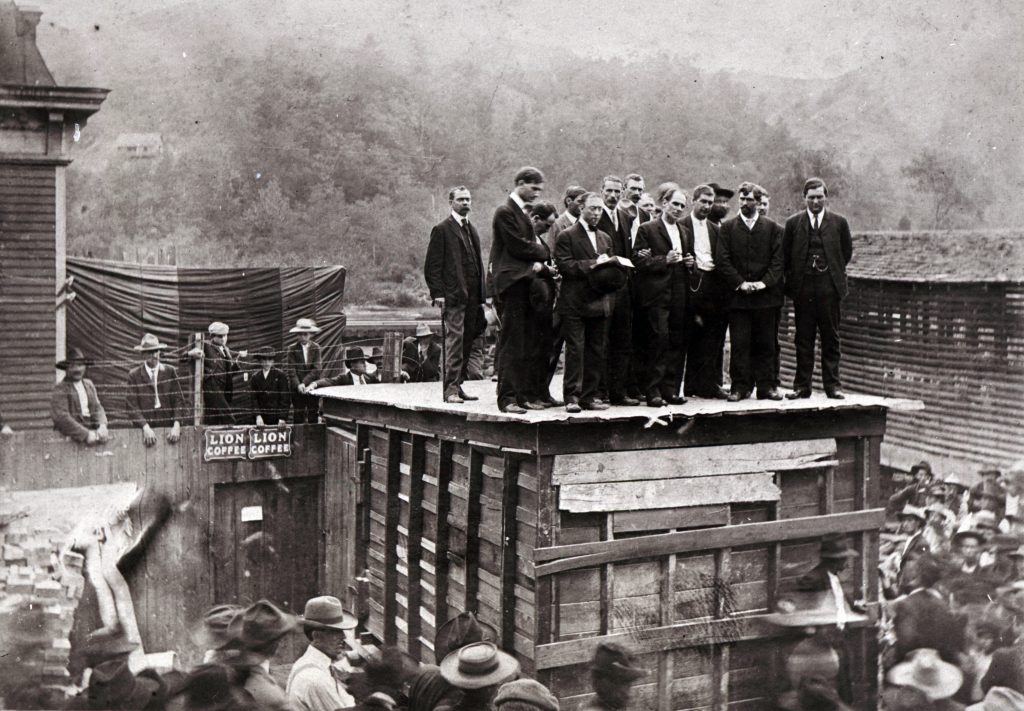

Chapter 2: Jim Crow & the Birth of the State-Run Death Penalty (1910-1961)
As the 20th Century began, the spectacle of public hangings carried out by local sheriffs in public parks, and attended by crowds of picnicking spectators, became an embarrassment to Southern states. So, as North Carolina sought its place in a modernizing world, the state centralized and sanitized the death penalty.
The state took over executions for all 100 counties, and an electric chair was installed at Central Prison in Raleigh. In March 1910, Walter Morrison, a Black man convicted of rape in Robeson County, became the first to die by electrocution. At public hangings, African Americans had often come to protest and pray with the condemned person. Now, the audience was tightly controlled. Often, the only Black person present was the one being killed.
Between 1910 and 1961, the state executed 362 people behind Central Prison’s closed doors. Almost 80 percent of them were Black.
Death in the electric chair could be protracted and horrifying, and executions began to spark public outrage. In response, the state built the first gas chamber, a simple airtight enclosure around the electric chair. Asphyxiation by poison gas turned out to be no less grisly than electrocution, but it remained in use until the 1990s, when North Carolina settled on lethal injection as the sole method of execution.
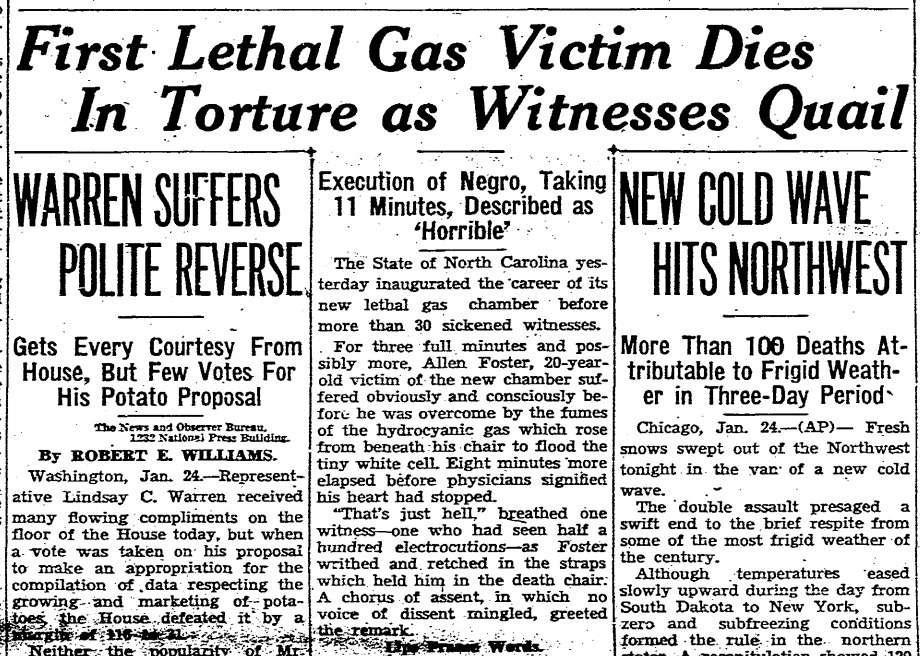
In this period, the state also winnowed the crimes punishable by death to four: arson, burglary, rape, and murder. But this reform did not reflect a turning away from the death penalty. To the contrary, executions climbed.
Between 1910 and 1961, the state executed 362 people behind Central Prison’s closed doors. Almost 80 percent of them were Black. And African Americans made up 90 percent of those executed for burglary and rape, crimes perceived by whites to be the most racially transgressive.
The state’s attempts at modernization changed only the appearance of the death penalty. They did nothing to alter the racialized fear and anger that lay at the heart of capital punishment. Lynchings continued and some trials closely resembled them, with angry mobs attempting to kidnap the accused from jails and courtrooms, and juries returning death sentences after only minutes of deliberation.

Chapter 3: Backlash to Civil Rights & the Creation of the Modern Death Penalty (1961-1990)
In the early 20th century, white people used public violence — including lynchings and executions — to ensure that Black people could not build economic or political power. But by mid-century, Jim Crow was written into the statute books and firmly enforced by white society. By the 1950s, North Carolina had succeeded in depriving African Americans of all meaningful civil rights and relegating them to second-class citizenship. Both lynching and the death penalty went into a steep decline. After 1961, state executions stopped altogether.
“Law and order” became the rallying cry for those opposed to the Civil Rights Movement. Once again, those hoping to maintain the racial order looked to the death penalty as a potent symbolic tool.
The Civil Rights Movement changed the national landscape. Ignited by the murders of Black servicemen returning to the South after World War II, the 1955 lynching of 14-year-old Emmett Till, the Montgomery Bus Boycott, and the Greensboro sit-ins, the world began to question the South’s oppressive social structure. Then, in 1972, the U.S. Supreme Court capped a series of polarizing decisions — including desegregating schools and outlawing poll taxes — by striking down the death penalty nationwide. The court said its imposition was arbitrary, and often racist.

Death penalty abolition was immediately met with fierce resistance. “Law and order” became the rallying cry for those opposed to the Civil Rights Movement. Support for capital punishment, which had been plummeting nationally, suddenly spiked. Once again, those hoping to maintain the racial order looked to the death penalty as a potent symbolic tool.
Just a few years later, in 1976, the Supreme Court reinstated the death penalty. The justices acknowledged that the public’s lust for lynching was part of the reason, writing that the death penalty was necessary to avoid “the seeds of anarchy — of self-help, vigilante justice, and lynch law.” So began the “modern era” of the U.S. death penalty, built explicitly upon a foundation of racial terror. Unsurprisingly, it continued to disproportionately punish people of color for crimes against white victims, while juries remained mostly white.
In North Carolina, this new era spawned charismatic prosecutors like Joe Freeman Britt in Robeson County, who was named the “deadliest prosecutor in America” by the Guinness Book of World Records. Among the more than three dozen death sentences he won were those of brothers Henry McCollum and Leon Brown, African American teenagers with profound intellectual disabilities. They served three decades for a murder they didn’t commit before being exonerated in 2014.
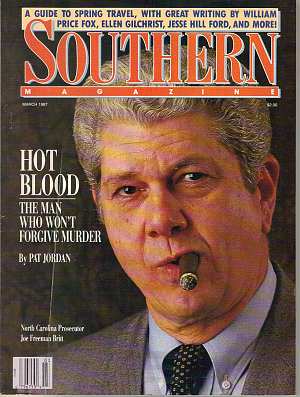
In 1987, the Supreme Court essentially condoned the continued racism in the death penalty. In McCleskey v. Kemp, the court acknowledged the death penalty’s racially disproportionate impact but allowed executions to continue anyway. The decision barred defendants from using the most compelling evidence of racism, statistics revealing pervasive patterns, and paved the way for the deadly decade to come.

Chapter 4: The Death Penalty in the Age of Mass Incarceration (1990-Present)
In the 1990s, the old forces of racism took a virulent new form: mass incarceration. Politicians competed to varnish their “tough on crime” credentials. They embraced the myth of young, Black “superpredators” and waged the War on Drugs. Thanks in large part to the policies of this period, the United States has the highest incarceration rate in the world.
The death penalty roared back to life, assuming a symbolic role at the apex of this system. In 1992, Presidential candidate Bill Clinton left off campaigning in New Hampshire to preside over the execution of Ricky Ray Rector, a Black man so brain damaged and intellectually disabled that he asked the guards serving his final meal to save dessert so he could eat it the next day.
North Carolina’s death sentencing rate soared to one of the nation’s highest, even beating out Texas. At the height of the frenzy, juries handed down as many as thirty-four death sentences in one year.
North Carolina led the death penalty’s resurgence. Its courts adopted the country’s most expansive death penalty rule, requiring prosecutors to seek the death penalty for nearly every first-degree murder. North Carolina’s death sentencing rate soared to one of the nation’s highest, even beating out Texas. At the height of the frenzy, juries handed down as many as thirty-four death sentences in one year, as opposed to no more than one or two per year today.

In some capital cases, jurors have described openly racist deliberations among all-white panels. One juror who sent a Black man to death row used racist epithets and admitted that bigotry was behind his desire to serve on the jury. And in case after case, prosecutors used racist language to entice white juries to vote for death — encouraging them to weave the metaphorical strands of evidence into a “rope” or referring to a defendant as a “big Black bull.” One elected district attorney celebrated death sentences by handing out noose-shaped lapel pins to his staff. Several of the people his office prosecuted in the 1990s remain on death row today.
The wave crested in 2001 after advocates pushed through a series of reforms intended to support public defense and ensure fair trials, and after the legislature ended the egregious requirement that every aggravated first-degree murder be tried capitally. The N.C. Innocence Inquiry Commission was formed, and a flurry of exonerations began, both on and off death row. Ten people sentenced to death in North Carolina have been exonerated, nine of them men of color. In 2009, the Racial Justice Act, which allowed people on death row to prove their sentences were racially-driven, uncovered statewide evidence that defendants with white victims were two times more likely to be sentenced to death and that Black jurors were systematically excluded.
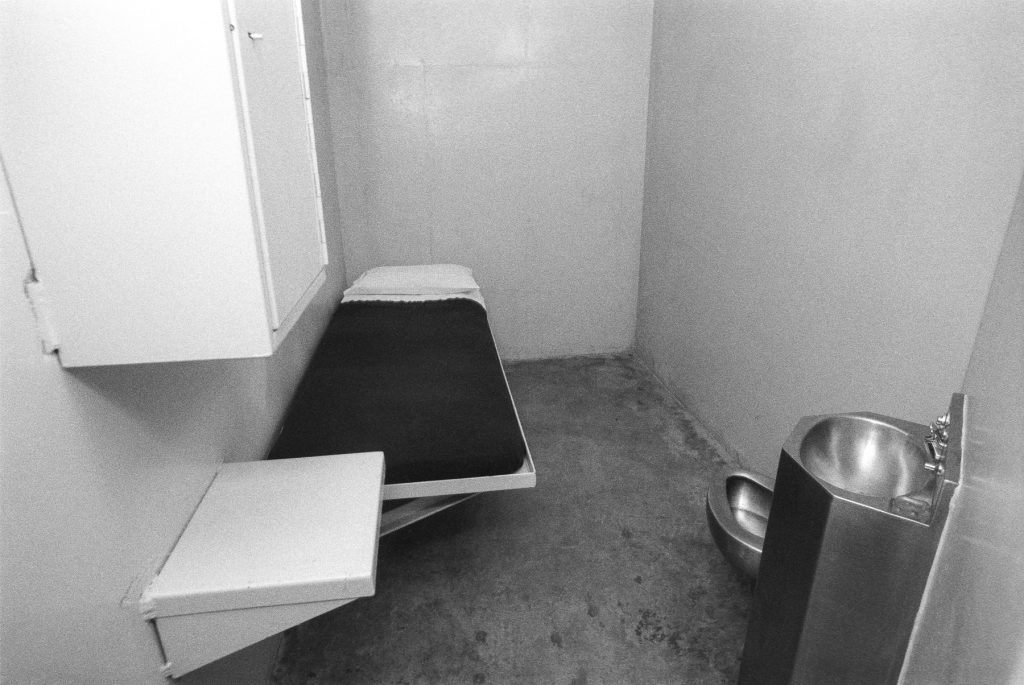
Despite the changes of the past two decades, North Carolina still claims one of the nation’s largest death rows with about 140 people, almost all sentenced in the 1990s. Its residents are disproportionately black and almost exclusively poor. Most are accused of crimes against white victims. Many had all-white juries. And the state continues its fight to execute them.
Rather than face up to the racism exposed by the Racial Justice Act, the legislature repealed it and prosecutors fought to keep the evidence out of court. But in June 2020, the N.C. Supreme Court cleared the way for all of the state’s Racial Justice Act claims to finally be heard. The evidence will show that North Carolina’s modern death penalty springs from the roots of a racist past.
